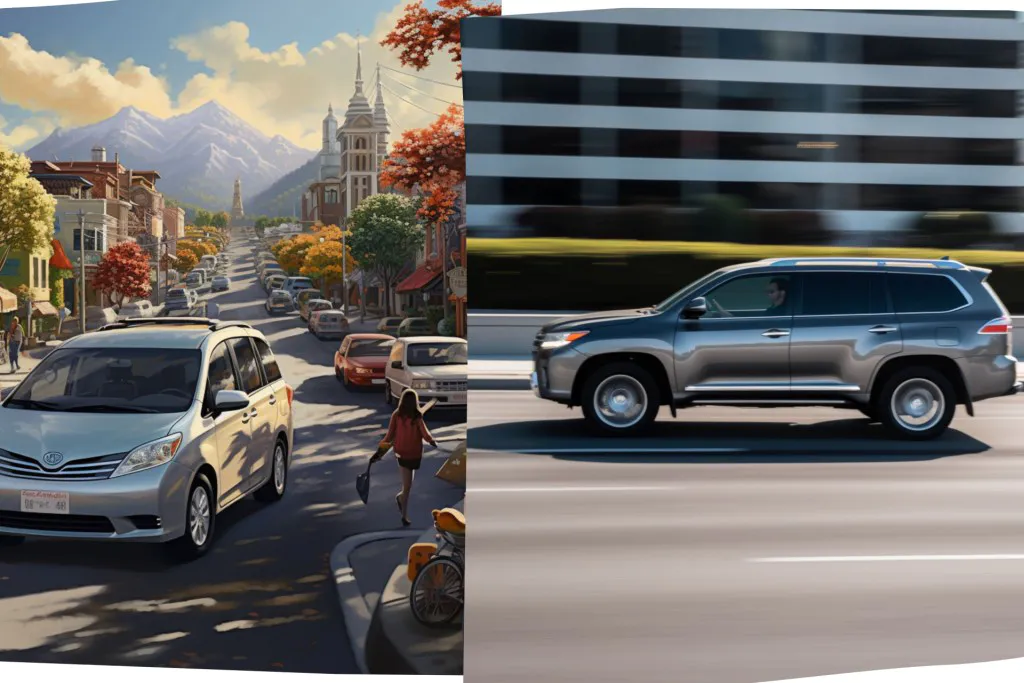There was a time when station wagons were the nerd-mobile to be avoided at all costs by drivers toting kids. These days, the minivan has taken the wagon’s place, while the omnipresent SUV owns the cool factor for this crowd. But what if you’re on the fence around this topic and aren’t sure which is best?
Well, turns out Toyota offers both! There’s the large-ish Highlander SUV and full-on sliding-door Sienna minivan. Both have their charms, but one is arguably better for family use than the other as we’ll dive into below.
Regardless of which way you go, be sure to focus on the 2012 through 2021 Sienna and 2002, 2007, 2009, 2010, 2012, 2015, 2017, 2019, or 2021 Highlander as these models offer the best blend of reliability and value.
| Income Bracket | Monthly Financing Cost Range | Cash Purchase Price Range | Toyota Sienna Years | Toyota Highlander Years | Best Model Year: | Why? |
| <$5k | $42-$83 | $1,500-$3,000 | N/A | N/A | N/A | Only Siennas from our list of worst model years fit this price range and the cheapest Highlander starts above $3,000 |
| $5k-$10k | $83-$125 | $3,000-$4,500 | N/A | 2002 | 2002 Highlander | Only the 2002 Highlander is a “best of” option at this price point |
| $10k-$15k | $125-$187 | $4,500-$6,750 | N/A | 2007 | 2007 Highlander | It’s the only option with a “best of” ranking for this price range |
| $15k-$25k | $187-$312 | $6,750-$11,250 | 2012, 2013 | 2009, 2010 | 2013 Sienna | More reliable than the Highlander and cheaper to maintain |
| $25k-$35k | $312-$437 | $11,250-$15,750 | 2014, 2015 | 2012, 2015 | 2015 Highlander | Perfect reliability rating and better fuel economy than the Sienna |
| $35k-$50k | $437-$625 | $15,750-$22,500 | 2016, 2017, 2018 | 2017 | 2018 Sienna | Better reliability scores than the Highlander and lower upkeep costs |
| $50k-$74k | $625-$925 | $22,500-$33,300 | 2021 | N/A | 2021 Sienna | It’s the only option from our “best of” rankings in this price bracket |
See the methodology for the table above.
A debate rages among the parenting set – to minivan or not to minivan? In one corner, you have nerds such as myself spouting off on the wonders of sliding doors in parking lots. In the other, you have those who would rather walk to soccer practice – with all the gear – than be caught driving such a lame vehicle.
It’s not as though the mighty crossover is without its charms what with car-like handling and high-riding visibility. But today’s comparison of the Toyota Sienna vs.Toyota Highlander is about more than my petty argument that minivans are better than SUVs.
No, this matchup will bring together objective and subjective reliability data, safety scores from the National Highway Traffic Safety Administration (NHTSA), resale values per Kelley Blue Book (KBB), fuel economy figures published on FuelEconomy.gov, annual upkeep costs per owner surveys, and the table above.
That table offers a quick view of what to expect based on your budget. Each row notes the best model year Toyota Sienna and best model year Toyota Highlander according to income range, monthly financing costs, and purchase price per KBB.
For a model year to make it into a given row, it needs to have already been selected as a “best of” according to our deep-dive Best and Worst Model Years series, which covers the Sienna and Highlander. Then, we pick a winner for each row with a quick reason as to why.
We’ll go deeper into the why below, but the goal here is to give would-be buyers an answer to whether the Sienna or Highlander is better when buying a new 2023 model or buying a used version going back as far as 2001.
Toyota has a reputation for building reliable vehicles and the 20-years-plus that both of these vehicles have been on sale is a testament to that. But as with any automaker, some model years are better than others and in this case, we’ll show you why one Toyota is better than another.
If you’re already browsing the classifieds, be sure to look through our used car buying checklist before responding to any “For Sale” ads. If you’d like to cross-shop the Toyota Sienna and Toyota Highlander, the following list of articles provides several relevant comparisons and model-specific analyses.
For minivan shoppers:
- Toyota Sienna vs. Honda Odyssey
- Best & Worst Model Years of the Honda Odyssey
- Best & Worst Model Years of the Chrysler Town & Country
- Best & Worst Model Years of the Dodge Grand Caravan
And for the crossover crowd:
- Toyota Highlander vs. Honda Pilot
- Toyota Highlander vs. Subaru Outback
- Best & Worst Model Years of the Honda Pilot
- Best & Worst Model Years of the Subaru Outback
- Best & Worst Model Years of the Ford Explorer
Price History Comparison | Toyota Sienna vs. Toyota Highlander
Average Market Value – Based on Owners’ Self-Reported Mileages | Toyota Sienna vs. Toyota Highlander

Looking over the chart above of Toyota Sienna vs. Toyota Highlander Market Value, you can see that, as expected, prices go down and mileage goes up as the years go on. It’s a useful way to see what model years are in your budget.
What’s interesting is that the Highlander is consistently more expensive than the Sienna. Over 20 years, that’s the case every time except in 2021. That year marked the arrival of the all-new 4th generation Sienna and a hybrid-only powertrain, so perhaps the enthusiasm for this modern minivan has driven prices up.
But why is the Highlander the pricier proposition the rest of the time? Looking back at historical data, a base Highlander was about $1,300 more than a base Sienna in 2001. Fast forward to 2023 and those baseline figures are within less than $300 of each other.
So, these vehicles have always been priced within striking distance of one another. This likely means the Highlander enjoys higher market values because it’s a crossover and not a minivan. The crossover segment has been on a tear for decades and the Toyota Highlander was one of the first to arrive in the midsize arena.
This means that if all else is equal – reliability, safety, etc. – the Sienna is a savvy purchase over the Highlander as you’re not paying for the crossover hype. That being said, it is always important to pay attention to mileage.
As you likely know, a vehicle with lots of miles accrued on long highway drives isn’t necessarily worse than a low-mileage vehicle that has seen mostly stop-and-go around-town duty. So be sure to dig into this history before buying used.
One year on the chart above that this topic comes into play is 2015. That year, the Sienna and Highlander were nearly equal in the eyes of Kelley Blue Book. And yet, according to owners, their Toyota Highlanders average 200,000 miles versus just 112,000 for the Sienna.
This suggests that people are willing to pay more for a Highlander than a Sienna even when the mileage differential is dramatic. That doesn’t make a whole lot of sense when you consider the 2015 Sienna was one of our picks for “best of” model years.
Conversely, the price differential in 2011 does make sense as those model-year Highlanders average 125,000 miles versus 170,000 for the Sienna according to owners. Bottom line? Do your homework on how those miles came to be before making a purchase.
For more analysis on this topic, check out the Best and Worst Model Year Sienna and Toyota Highlander articles.
Depreciation vs Maintenance Expenses
New cars are nice because they’re shiny, have that signature chemical soup aroma, and show little to no miles on the odometer. But used cars are nicer when you factor in depreciation. Fun fact: a new car drops in value by 10 to 15% after one year of ownership, a figure that can hit 50% in just 5 years.
Yes, an older car has more wear and tear which can result in more repair costs. But does this outweigh the horror show described by these Toyota Sienna and Toyota Highlander depreciation curves? Well, it can, if you know what to look for.
Which brings us to the charts above. The black box on each one – Sienna and Highlander – highlights a sweet spot of residual value (gray line) and maintenance costs per mile (green line). It’s here that you can find yourself a Toyota Sienna or Highlander that dodges depreciation without breaking the bank on maintenance.
In the case of the Sienna, that sweet spot is for the 2002 to 2010 model years where residual values are at or below 10% and average costs per mile of maintenance are 4 to 11 cents. In particular, the 2004 and 2008-2010 models come in on the low side for that latter metric.
However, be aware that none of these “sweet spot” model years get a thumbs up on our best and worst model year rankings of the Toyota Sienna. So, be sure to pay close attention to maintenance history related to engine reliability if you’re in the market.
Over on the Highlander chart, we can see the sweet spot is between 2003 and 2008, which means there are likely fewer options available for sale than the Sienna with its wider range of model years. And while the cents per mile metric is a bit lower at 4 to 9 cents, the residual values lean as high as 15%.
This jives with the market value chart from above that shows how the Highlander tends to be more expensive than the Sienna. In good news, this Highlander sweet spot includes the 2007 model year, which is one we recommend on our best and worst model year rankings of the Toyota Highlander.
Reliability Comparison | Toyota Sienna vs. Toyota Highlander
Looking over the chart above on the left, which compares the objective FIXD Reliability Score of the Toyota Sienna and Highlander between 2001 and 2021, it appears to be a mixed bag in terms of which Toyota performs better for this metric overall.
That’s because roughly half of those 21 model years, the Sienna is more reliable with the other half going to the Highlander. There are a few years where these figures are identical.
While it may seem logical to choose the option that is more reliable for a given year, be aware that per our Toyota Sienna best and worst model year rankings, the 2001 through 2011 Siennas are best avoided.
However, during that stretch, our best and worst model year rankings of the Toyota Highlander point to the 2007, 2009, and 2012 years as worth considering. So, while the Sienna meets or exceeds the Highlander’s reliability over this span, you should think twice before buying one.
The opposite is true of the 2012 through 2021 Sienna as we recommend any of these model years. But we only gave a thumbs up to the 2015, 2017, 2019, and 2021 Highlander. So although the 2020 Highlander has a higher FIXD rating than the 2020 Sienna, you’re better off with the Sienna when accounting for safety, fuel economy, repair costs, etc.
The other chart above shows what Sienna and Highlander owners think about their vehicle’s reliability based on survey responses. Something that jumps out is how highly both Toyotas rank in their owner’s eyes. For instance, 6 out of 10 is the lowest score of any year and most are at an 8 or higher.
Looking over this chart of Sienna vs. Highlander Owner Reliability Score, you can see why these models have both had such a long and successful lifecycle – they are well-loved by the people who buy them.
Longevity Comparison | Toyota Sienna vs. Toyota Highlander
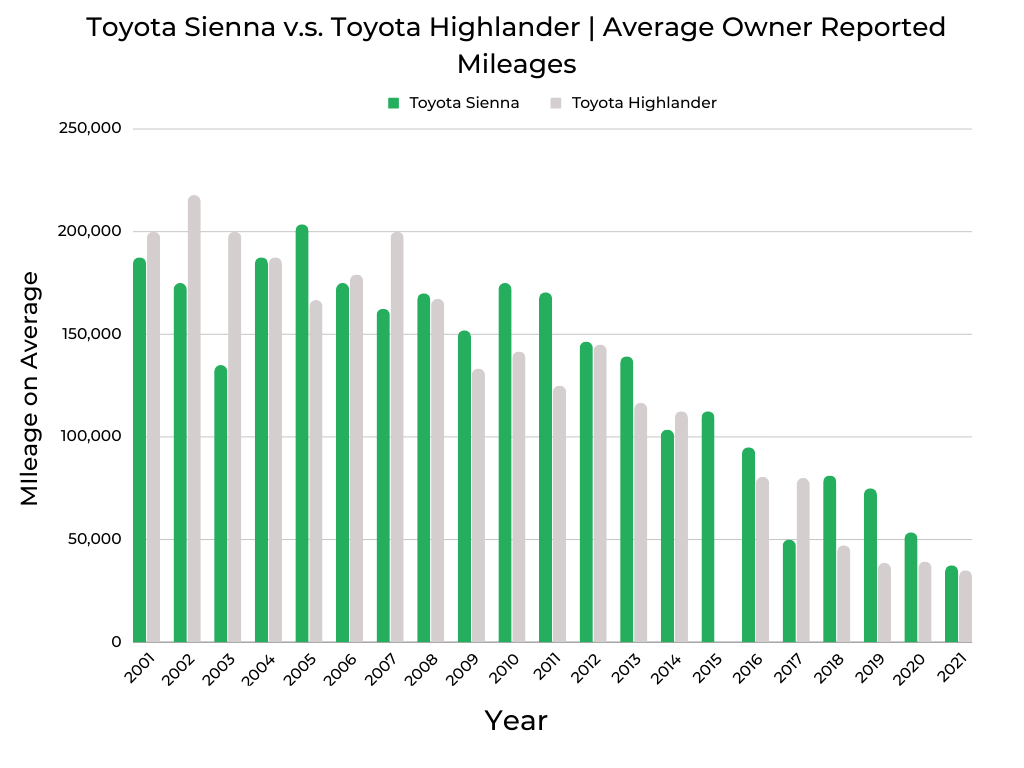
As with the reliability discussion from above, neither the Toyota Sienna nor Highlander owns the mileage conversation. In other words, there’s no clear trend that one of these Toyotas racks up more miles according to owner surveys.
The chart above, which compares owner-reported mileage of the Sienna and Highlander, reveals that those in the market for a used Sienna should aim for options with less than 150,000 miles. Why? Because Siennas from 2012 forward all fit this metric and are all on our “best of” side of the Toyota Sienna model year rankings.
As the list of Highlander model years that we recommend is spread all over the past 21 years, it pays to study our best and worst model year rankings of the Toyota Highlander to determine which offers the best balance of mileage against reliability, safety ratings, maintenance costs, and fuel economy.
One highlight on the chart above is the 2007 model year where we can see the Highlander touches 200,000 miles, while the Sienna is closer to 162,000 miles. That particular year falls into the Highlander’s depreciation sweet spot so it’s not too surprising that it tends to rack up more miles.
2023 Toyota Sienna vs. Toyota Highlander | A Guide to Trim Levels & Optional Features
Trim Levels: Starting Prices
We’ve discussed the used market for the Toyota Sienna and Toyota Highlander. If my admittedly pathetic powers of persuasion have not, uh, persuaded you that depreciation is the enemy, this article will also walk you through a detailed comparison of the 2023 Sienna and Highlander!
We’ll start with the price using the tables below. As mentioned earlier, the Sienna and Highlander have similar entry prices and, as it turns out, similar top-spec stickers. But while there are 7 trim lines to choose from on the 2023 Sienna, the 2023 Highlander offers 11.
Why? Because the Highlander can be had with a regular gas-powered engine or a hybridized setup as indicated by the nameplate. However, all 2023 Siennas are hybrids. This means you can get into one of Toyota’s super fuel-efficient hybrids for about $3,700 less if you choose the Sienna over the Highlander.
Keep in mind, that it’s the same 2.5L inline-4-based hybrid powertrain in both vehicles that earns the same fuel economy ratings. This raises the question of why you would bother with the non-hybrid Highlander. As we’ll look at below, it is a bit faster in the 0-60 mph sprint and can tow a bigger load.
Conveniently, Toyota applies a virtually identical naming convention to the various trim lines of the 2023 Sienna and Highlander. While the content is not 100% the same between vehicles, it’ll be pretty close and in both cases, AWD is available.
A couple of notable outliers are the Sienna Woodland Edition and Highlander Bronze Edition. In Woodland spec, the Sienna sits a bit higher off the ground, comes standard with AWD, and looks more outdoorsy. With the bronzed-out Highlander, AWD is also standard as is a sweet mid-century modern-inspired cabin vibe and sweeter bronze rims.
| 2023 Toyota Sienna Model | Starting Price |
| LE | $36,885 |
| XLE | $42,195 |
| XSE | $44,445 |
| Woodland Edition | $47,695 |
| 25th Anniversary Special Edition | $48,170 |
| Limited | $49,145 |
| Platinum | $52,345 |
| 2023 Toyota Highlander Model | Starting Price |
| L | $36,620 |
| LE | $39,020 |
| XLE | $42,020 |
| XSE | $43,615 |
| Limited | $46,275 |
| Platinum | $49,475 |
| Hybrid LE | $40,620 |
| Hybrid XLE | $43,620 |
| Hybrid Bronze Edition | $46,380 |
| Hybrid Limited | $47,875 |
| Hybrid Platinum | $51,075 |
2023 | Toyota Sienna vs. Toyota Highlander | Specifications | Safety, Interior and Exterior Features
For a comprehensive comparison of the 2023 Toyota Sienna minivan and Highlander crossover, it helps to understand each vehicle’s specs as we’ll dive into below.
Vehicle Class & Body Style:
According to the U.S. Environmental Protection Agency, the Toyota Sienna is a minivan and the Highlander is a midsize SUV. These classifications are based on passenger volume and cargo space, but don’t let the “mini” prefix to the Sienna’s category fool you.
If you haven’t spent time in a modern minivan like the Sienna or Honda Odyssey lately, be aware that they’re anything but mini. So, when you start comparing interior spaces to the likes of a midsize SUV such as the Highlander, there’s no contest.
We’ll look at this more closely below, but the Cliff’s Notes are that the Sienna has 11 more inches of third-row legroom, more than twice the third-row cargo space, and 20 more cubic feet of overall passenger volume than the Highlander.
| 2023 Toyota Sienna | 2023 Toyota Highlander |
|
| Class | Minivan | Mid Size SUV |
| 4-Door SUV | N/A | L, LE, XLE, XSE, Limited, Platinum, Hybrid LE, Hybrid XLE, Hybrid Bronze Edition, Hybrid Limited, Hybrid Platinum |
| 4-Door Minivan | EX, EX-L, Sport, Touring, Elite |
Powertrain:
Engine Options & Specifications:
If, for some reason, you’re not interested in a hybrid, only the 2023 Toyota Highlander offers a traditional gas-powered engine as the 2023 Sienna comes with a hybrid powertrain across the board. These non-hybrid Highlanders are cheaper than their hybrid stablemates, but the Sienna is the cheapest of all hybrids in this comparison.
And what do you get without hybridization on the Highlander? 22 more horsepower, a 6 MPH higher top speed, and a 0-60 MPH time that is about 1 second faster. None of those factors are likely high on the priority list for buyers.
But, the 5,000-pound towing capacity may be as it is 1,500 pounds higher than any Sienna or the hybrid Highlander can manage. All that said, these standard Highlanders have significantly worse fuel economy – 11 MPG on the combined scale – than hybrid models, which translates to a far shorter highway driving range.
As well, according to the EPA, a 2023 Toyota Highlander Hybrid should cost you roughly $1,450 in annual fuel costs. That figure spikes to $2,100, which is $650 higher, in the gas-powered variant. All of which makes the hybrid look pretty good.
Should you go that route, the Sienna and Highlander are almost identically matched from a spec perspective. As they share the same hybrid powertrain, the differences are negligible like a 2 HP advantage in the Sienna, slightly more driving range, and a 1 MPG advantage in the highway fuel economy rating.
But, as noted above, you can get into a hybrid-powered Sienna for $3,755 less than the base Highlander hybrid costs.
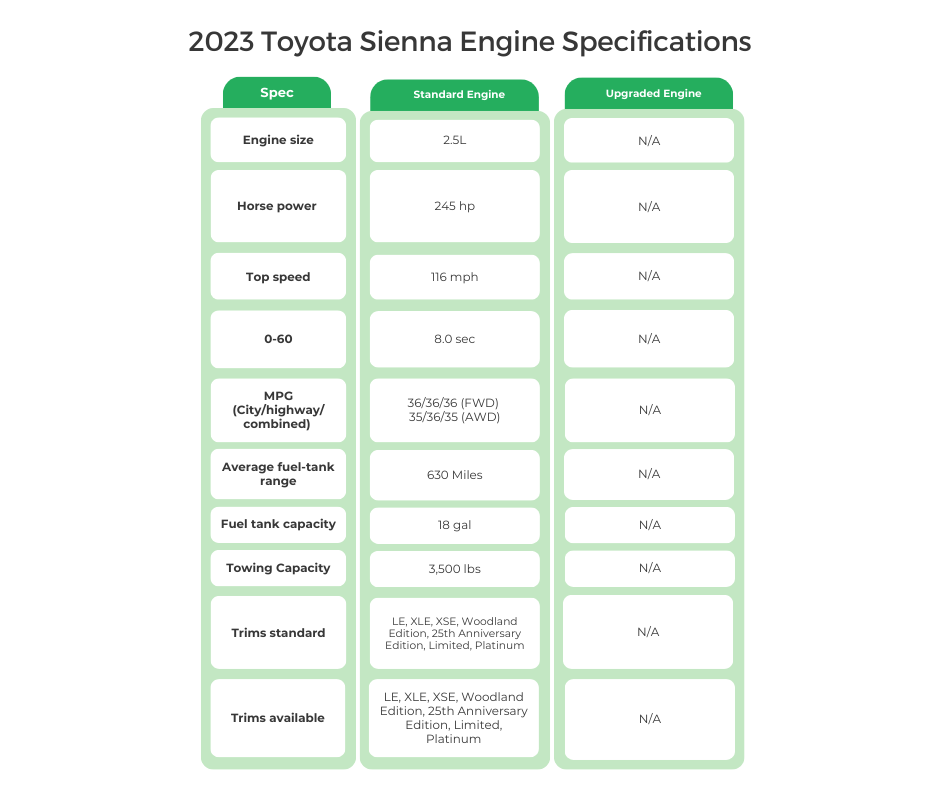
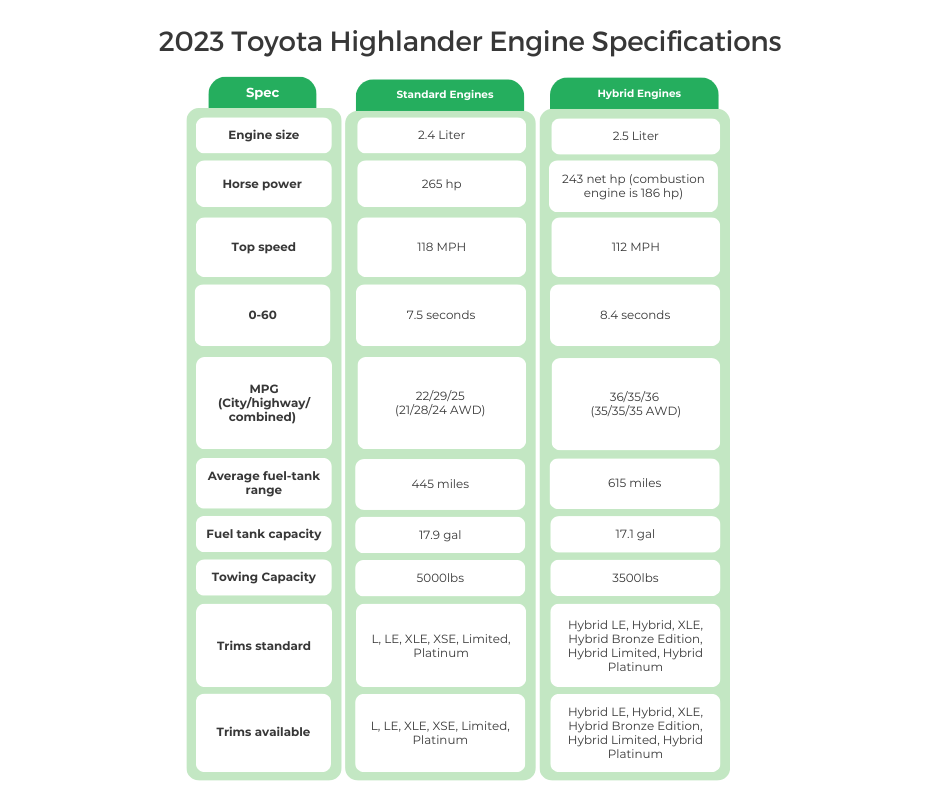
Transmission Options & Specifications:
If talking about transmissions isn’t at the top of your list, you can rest easy when it comes to comparing them on a 2023 Toyota Sienna and Highlander. In hybrid form – all Siennas and some Highlanders – Toyota fits a continuously variable transmission (CVT).
Should you pine for the traditional sounds of an automatic transmission, the gas-powered Highlander is your only option with its 8-speed unit. If you want more, be sure to check out the “Tech Talk” section below where we nerd out on belts, pulleys, and gear ratios.
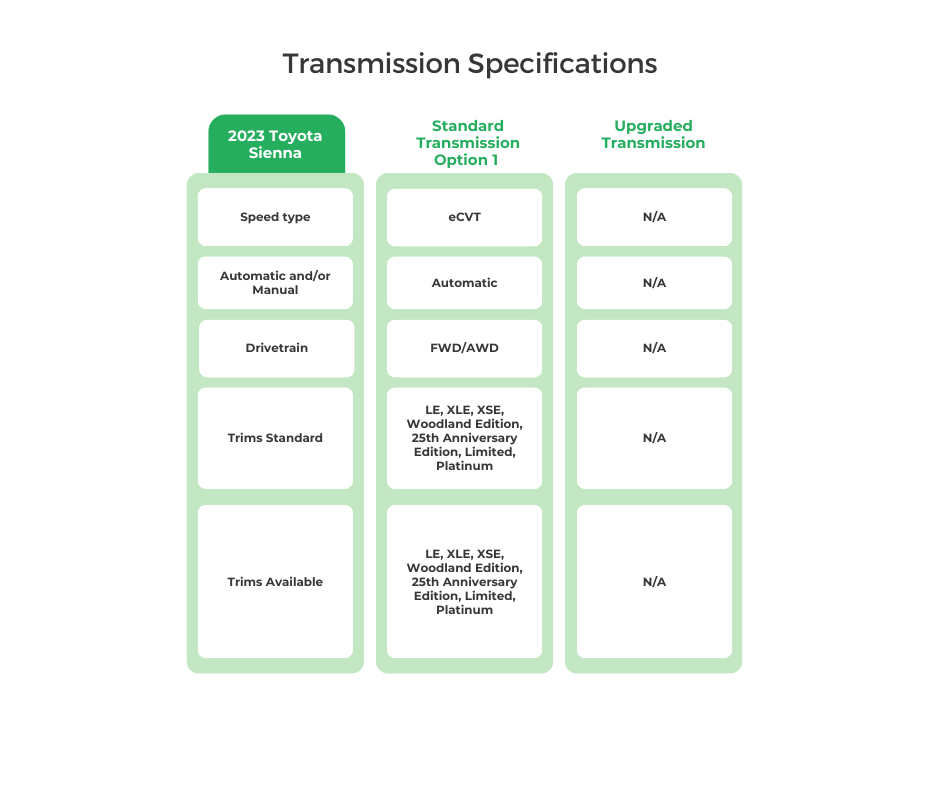
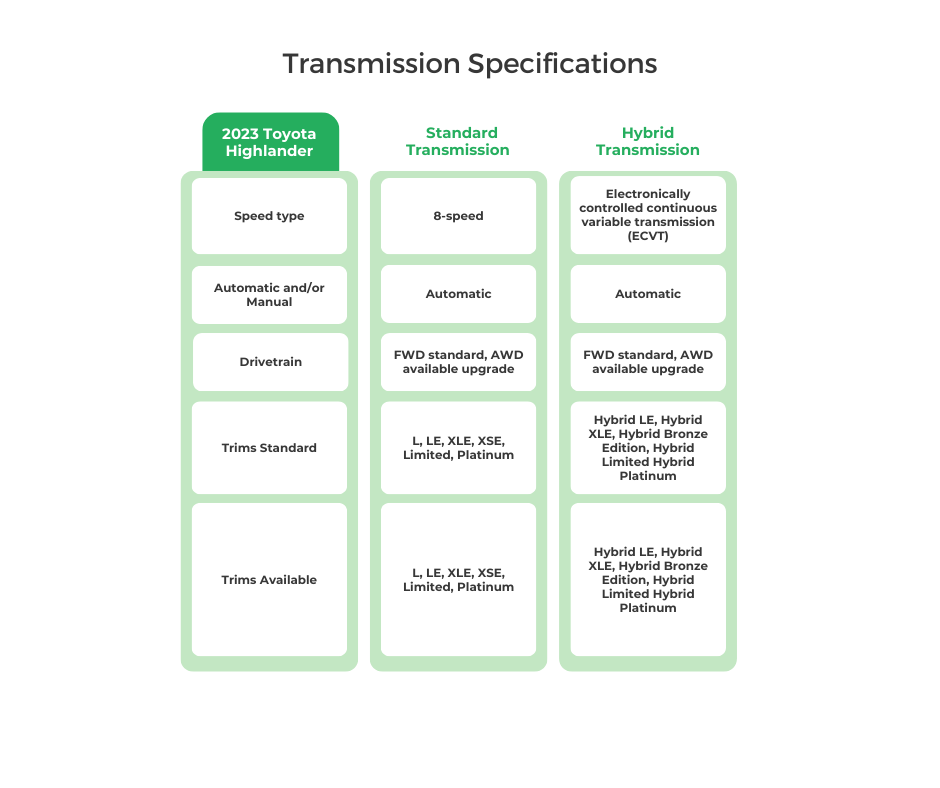
TECH TALK: CVTs
A continuously variable transmission (CVT) does not use gears like a typical automatic transmission. Instead, it has two pulleys connected by a belt. One pulley connects to the engine, and the other connects to the wheels. The belt transfers the power between the pulleys. This setup allows the pulleys to continuously change positions as needed. The CVT automatically adjusts the pulleys as required, providing smooth and efficient power delivery.
An electronic continuously variable transmission (eCVT) uses electronic controls and electric motors to vary gear ratios instead of a belt and pulley system. Unlike a regular CVT, an eCVT has no physical pulleys or belts—the gear ratio is adjusted seamlessly by controlling the speeds of electric motors and generators. This electronic control allows faster, smoother gear ratio changes compared to a traditional CVT. An eCVT also provides more flexibility, needing less space and having fewer moving parts.
Wheel Drive:
As you may have already figured out, the 2023 Toyota Sienna and Highlander share a platform. So along with common hybrid engines and transmissions, they both come standard with front-wheel-drive (FWD). All-wheel-drive (AWD) is a $1,000 to $2,000 option across the board except for the Sienna Woodland Edition which comes only with AWD.
Keep in mind that contrary to the off-road-ish vibe the Woodland model gives off and the SUV style of the Highlander, these AWD systems are aimed at adding traction when the roads are slick. Off-roaders these Toyotas are not.
| 2023 Toyota Sienna Wheel Drive | FWD | AWD | RWD |
| LE | S | E | |
| XLE | S | E | |
| XSE | S | E | |
| Woodland Edition | E | ||
| 25th Anniversary Edition | S | E | |
| Limited | S | E | |
| Platinum | S | E |
| 2023 Toyota Highlander Wheel Drive | FWD | AWD | RWD |
| L | S | U | |
| LE | S | U | |
| XLE | S | U | |
| XSE | S | U | |
| Limited | S | U | |
| Platinum | S | U | |
| Hybrid LE | S | U | |
| Hybrid XLE | S | U | |
| Hybrid Bronze Edition | S | U | |
| Hybrid Limited | S | U | |
| Hybrid Platinum | S | U |
U = Available in upgrade
E = electric on-demand AWD
D = AWD with rear driveline disconnect
Safety:
NHTSA Safety Ratings:
As both the 2023 Sienna and Highlander are primarily family vehicles according to FIXD owner survey responses, it’s nice to know they both score highly in the NHTSA’s crash-testing protocols. You don’t have to choose one over the other here as the scores are identical across the board.
Regardless of whether you choose a hybrid or not and FWD or AWD, the 2023 Toyota Sienna and Highlander earn a 5-star overall rating, a 4-star frontal crash rating, 5 stars for the side crash test, and a 4-star rollover rating.

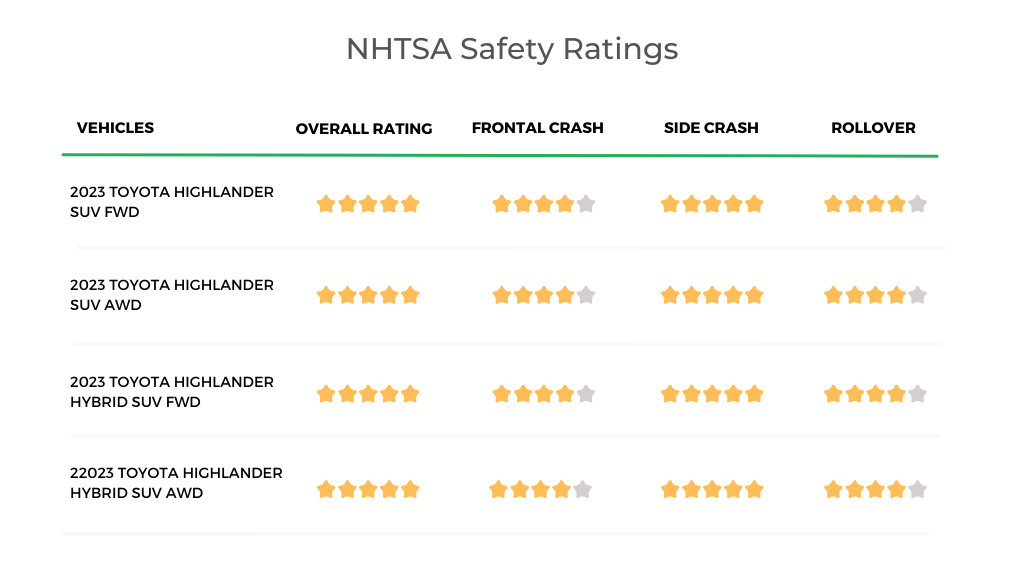
IIHS Awards:
Burnishing Toyota’s reputation for building safe vehicles is the fact that both the 2023 Sienna and Highlander have taken home the Top Safety Pick+ award from the Insurance Institute for Highway Safety (IIHS).
Like the NHTSA, the IIHS performs crash testing on vehicles, but it makes the testing more comprehensive by adding protocols for the evaluation of roof strength, head restraints & seats, headlights, and advanced safety nets like automatic emergency braking.
Instead of using stars to rank safety, the IIHS awards ratings of Good (the best), Acceptable, Marginal, and Poor (the worst). For vehicles with exceptionally high testing performance, like our comparison subjects, the IIHS gives out Top Safety Pick (TSP) and TSP+ awards.
To earn the plus sign, a vehicle must have ratings of Good for all crash tests versus the TSP rating that allows for an Acceptable score in the side crash test. It’s just one more data point to support how safe these Toyotas are.
| IIHS Award | Tested Vehicle | ||
| 2023 Toyota Sienna |
MINIVAN | 2023 TOP SAFETY PICK + | 2021 Toyota Sienna LE and XLE Hybrid |
| 2023 Toyota Highlander |
Midsize SUV/4-Door SUV | 2023 TOP SAFETY PICK + | 2020 Toyota Highlander LE 4-door AWD |
Airbags & Head Restraints:
It’s easy to take airbags for granted in modern cars considering how ubiquitous they are. But, given how effective those airbags are in keeping occupants safe in the event of a crash, it’s worth taking the time to understand how many are used in any new vehicle.
As you can see in the tables below, both the 2023 Toyota Sienna and Highlander come standard with front-impact, side-impact, and driver-side knee airbags. But the Sienna manages to fit a total of 10 airbags into its body versus 8 in the Highlander.
The primary difference between them is that the Sienna includes dual seat-mounted outboard side airbags for the second row, which is not the case with the Highlander.
Also illustrated below is that neither the Sienna nor Highlander comes with overhead airbags or active head restraints. Overhead airbags are a relatively new addition to the industry that offer additional head protection, while active head restraints are designed to reduce whiplash in rear-end collisions and are more common on high-end vehicles.

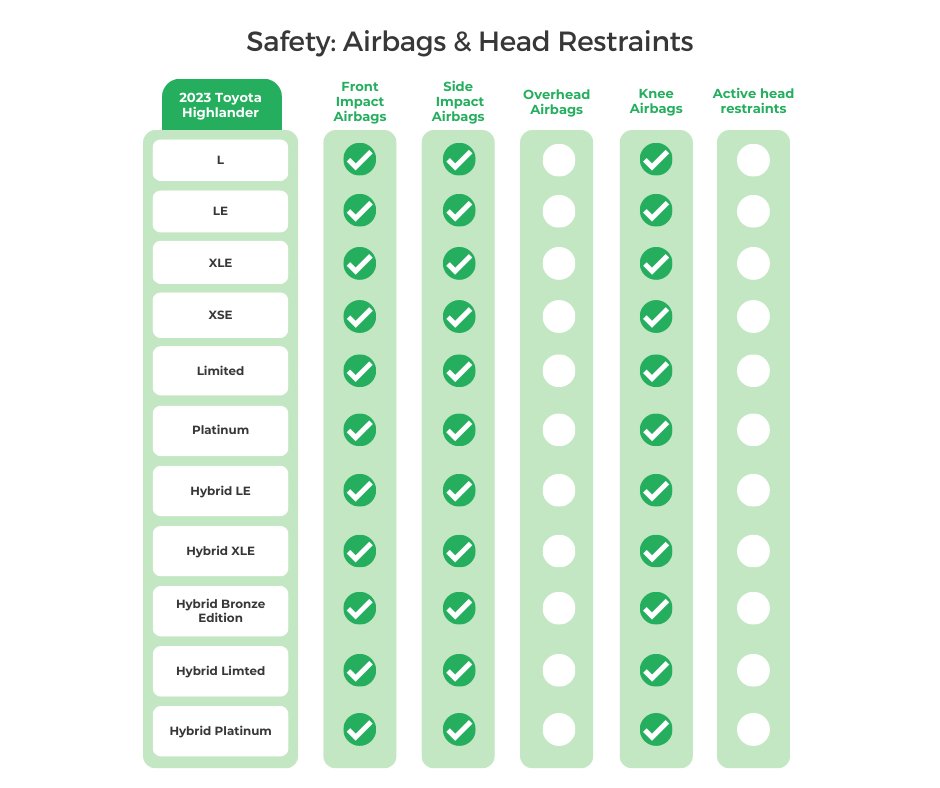
Semi-Autonomous Driving:
True hands-free driving has not yet made its way into the 2023 Toyota Sienna or Highlander, but there are still plenty of standard advanced driver-assistance systems (ADAS). And thanks again to platform-sharing, you need not pick one over the other due to ADAS as they both come with the same standard systems.
Toyota Safety Sense (TSS) is the automaker’s name for its bundle of these systems which includes forward collision mitigation (FCM), adaptive cruise control (ACC), and a lane-keeping system (LKS).
FCM can warn you of an impending impact and hit the brakes if you don’t. ACC can match your speed to the vehicle in front of you – speeding up and slowing down as needed to maintain a safe distance- and even come to a complete stop, which is a boon in bumper-to-bumper traffic.
With LKS running at the same time as ACC, your Toyota will work to keep you centered between the lane lines, alert you if you get too close to those lines without using a turn signal, and steer you back into position should you get too far afield.
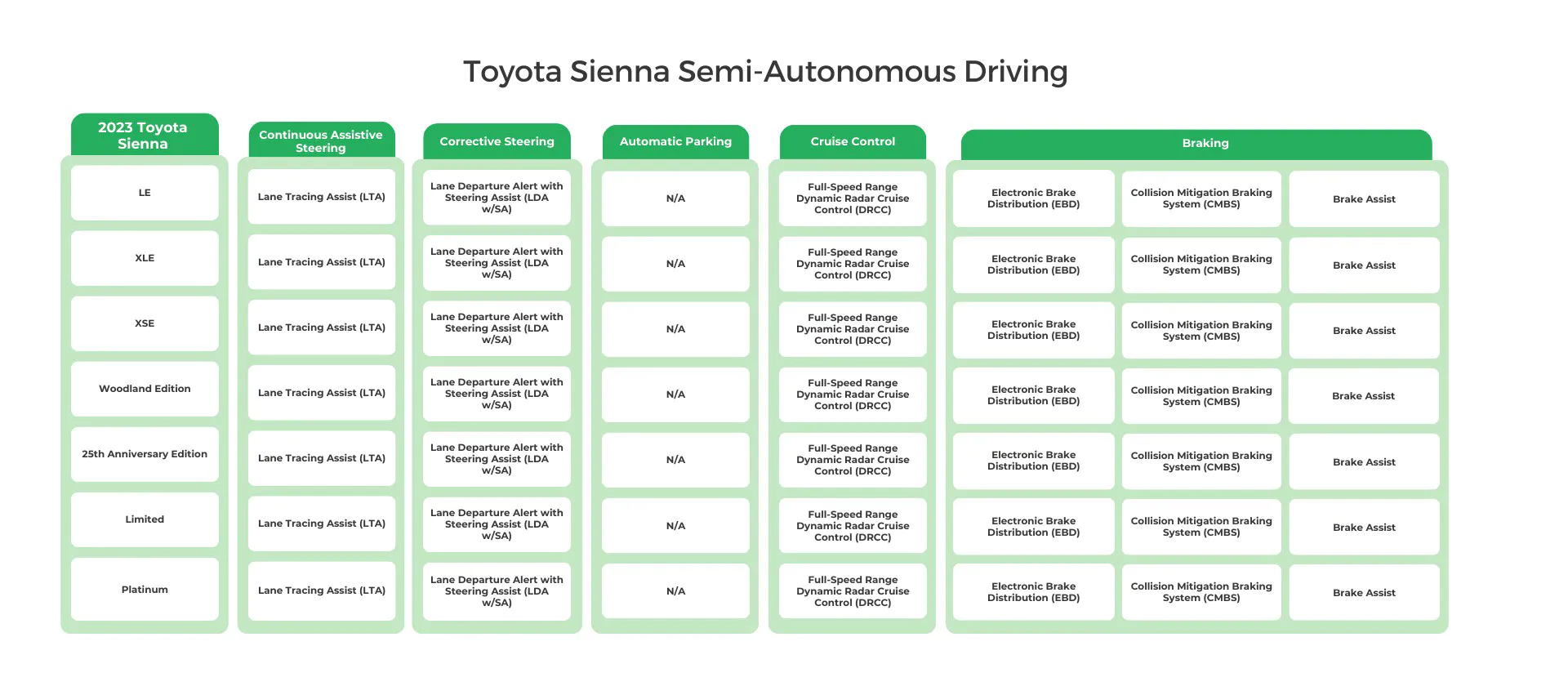
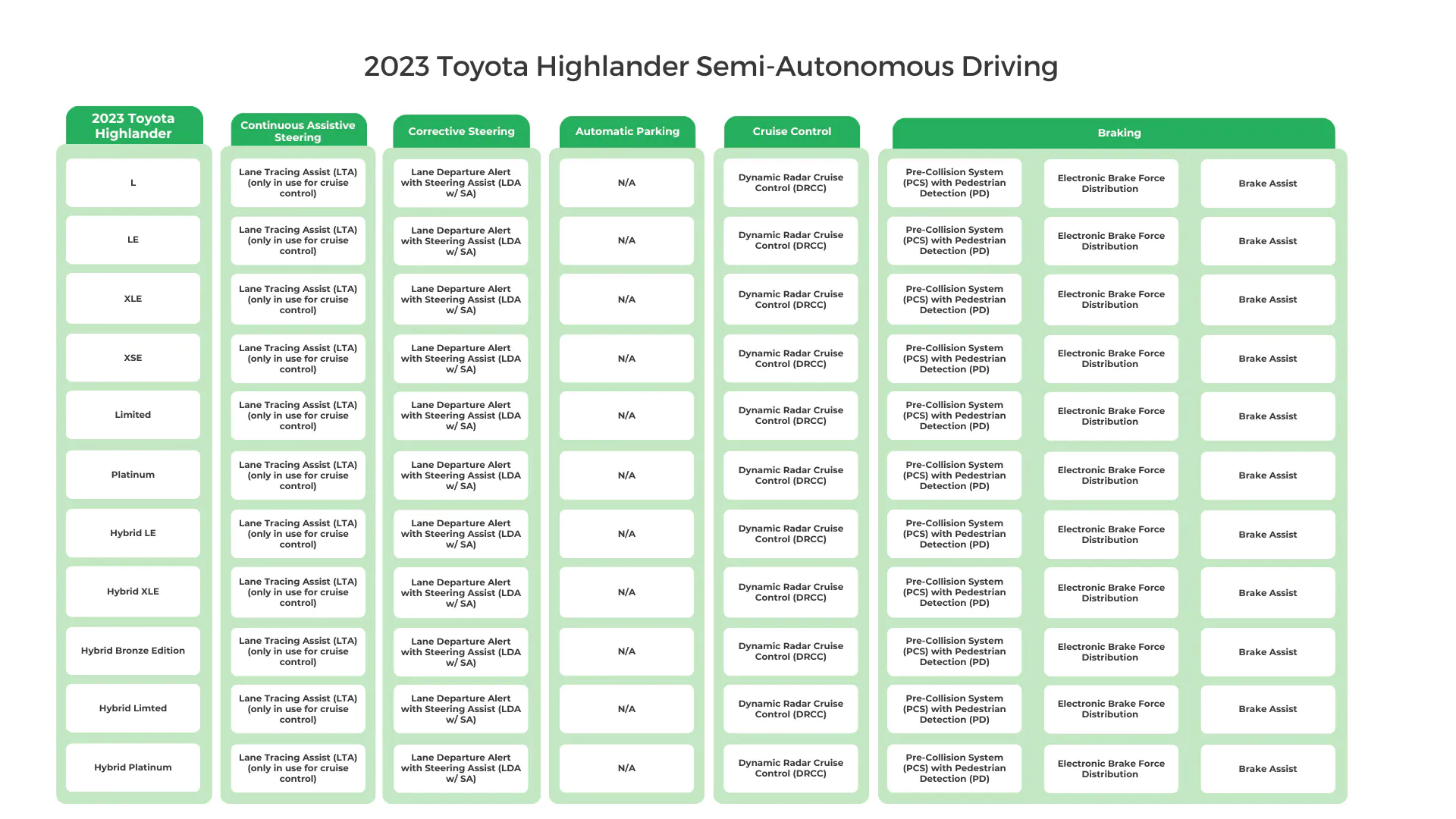
Driver Warning Systems & Telematics:
The TSS bundle of driver aids has additional systems on top of FCM, LKS, and ACC. In both the 2023 Sienna and Highlander, blind-spot monitoring (BSM) and rear cross-traffic alert (RCTA) are lineup standard – with the exception of the base Highlander.
Without exception, traffic sign recognition (TSR), and a rear occupant alert (ROA) are standard. TSR displays pertinent traffic sign details on the gauge cluster screen, and ROA reminds drivers when someone is still in the back seat. However, neither Toyota offers a driver attention monitor or safe exit assist.
Telematics, or what Toyota dubs “Connected Services”, are becoming more commonplace in the age of connected vehicles. With the 2023 Sienna and Highlander, a trial period of varying length is included for Remote (except on the base Sienna), Safety, Wi-Fi, and Service Connect.
The Remote Connect service enables app-based control of vehicle functions like the door locks and engine start. Safety Connect has an emergency assistance button within the car and an automatic collision notification feature. Wi-Fi Connect refers to the vehicle hotspot and Service Connect sends reminders when it’s time for maintenance.
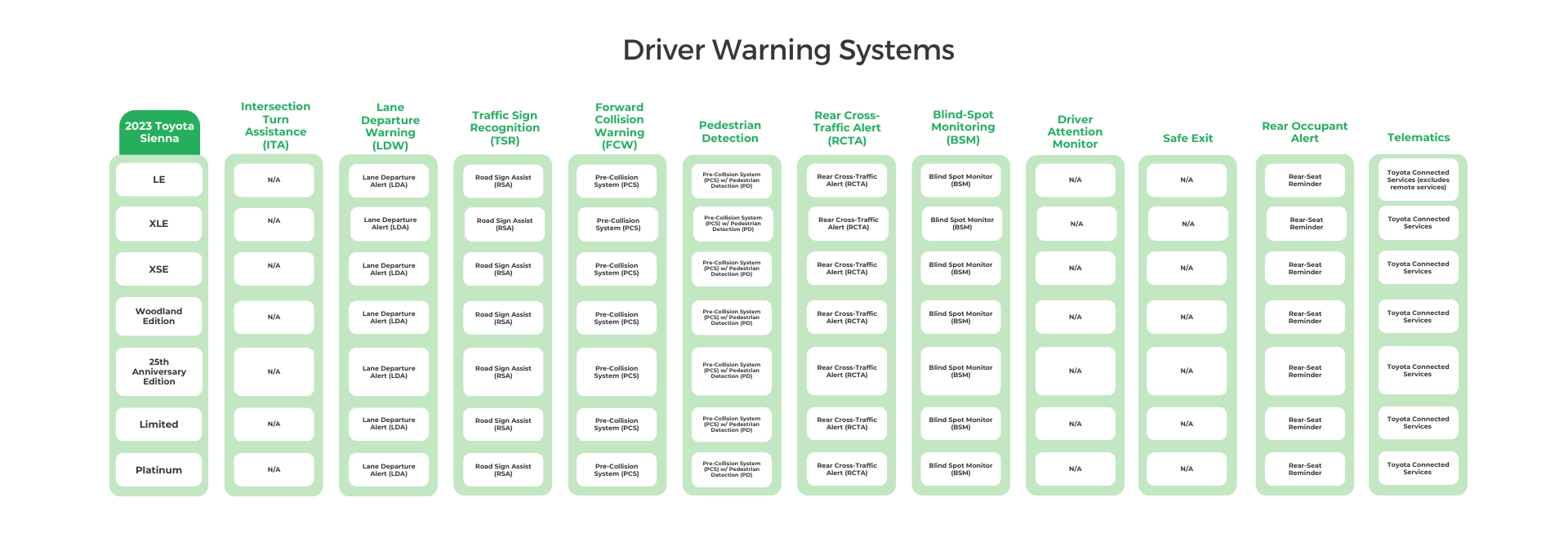
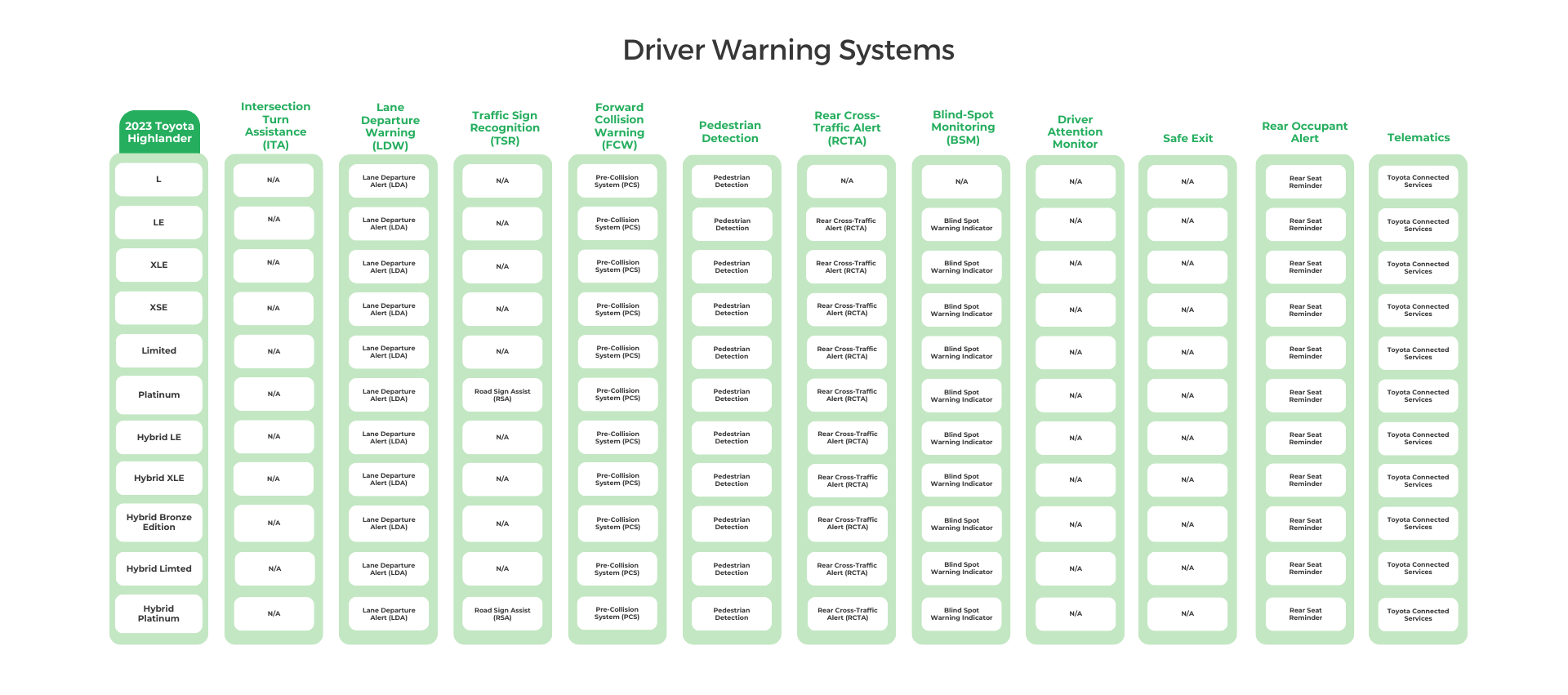
Road Visibility Features:
For additional safety, Toyota makes LED headlights standard across the 2023 Sienna and Highlander lineup, which are truly night and day compared to old-school halogen lighting when it comes to nighttime driving. Automatic high beams are also included and just like it sounds, can switch the high beams on and off for you.
Going deeper down the fascinating rabbit hole of modern headlights are the adaptive units that are only included on the Highlander Platinum. These headlights rotate the bulbs in concert with steering wheel movement for help seeing around corners.
Backup cameras have been federally mandated since 2018, but head-up displays (HUD) and rain-sensing wipers are still a premium feature. HUDs, which project information like current speed onto the windshield in the driver’s line-of-sight, are standard on all Sienna and Highlander Platinum models as are the rain-sensing wipers that manage wiper speed for you.
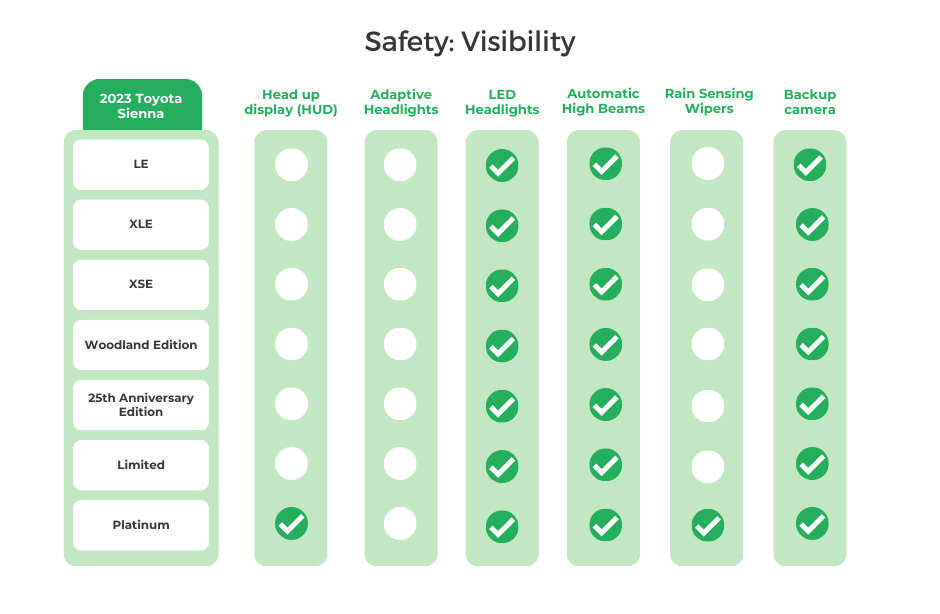
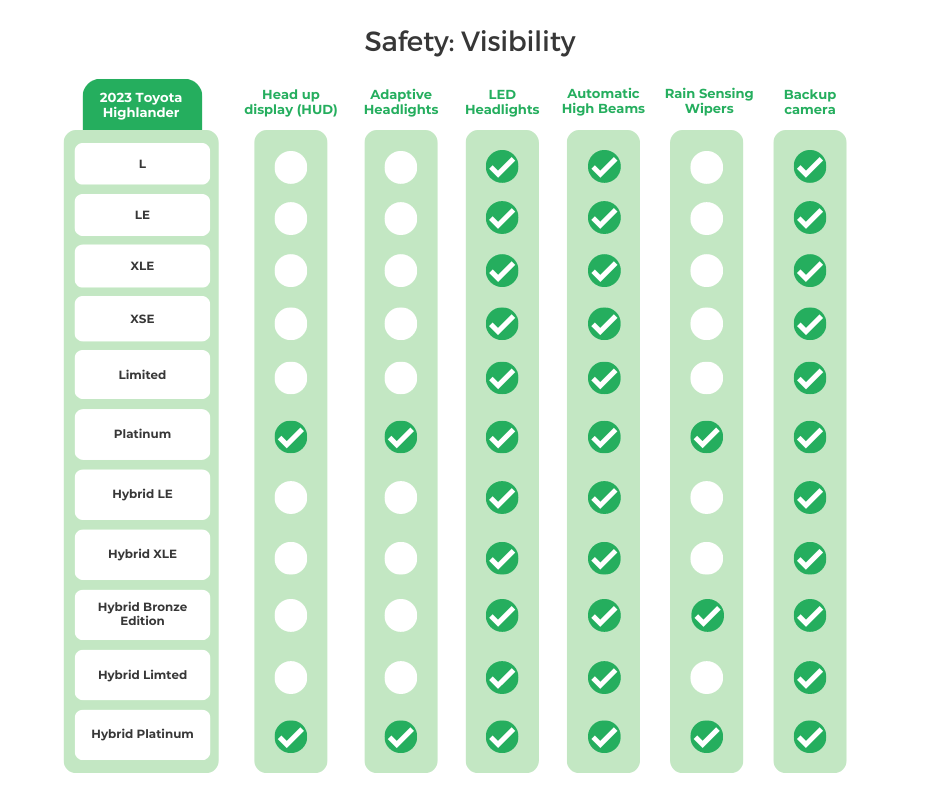
Interior:
Interior Features:
Apple CarPlay and Android Auto, software systems that cast – or mirror – an owner’s smartphone screen onto the infotainment display are practically expected standard content these days. So, no surprise that both the 2023 Toyota Sienna and Highlander come standard with both systems.
Heated seats, however, are still desirable but not quite assumed. In both the Sienna and Highlander, heated front seats don’t become standard until the XLE trim line.
Subscription-based heated seats, a “Features On Demand” concept that most car buyers are still unfamiliar with and skeptical of, are part of a burgeoning industry that McKinsey says is set to take off. BMW recently botched the use of a heated seats subscription, but you can expect to see more FOD-related efforts among automakers going forward.
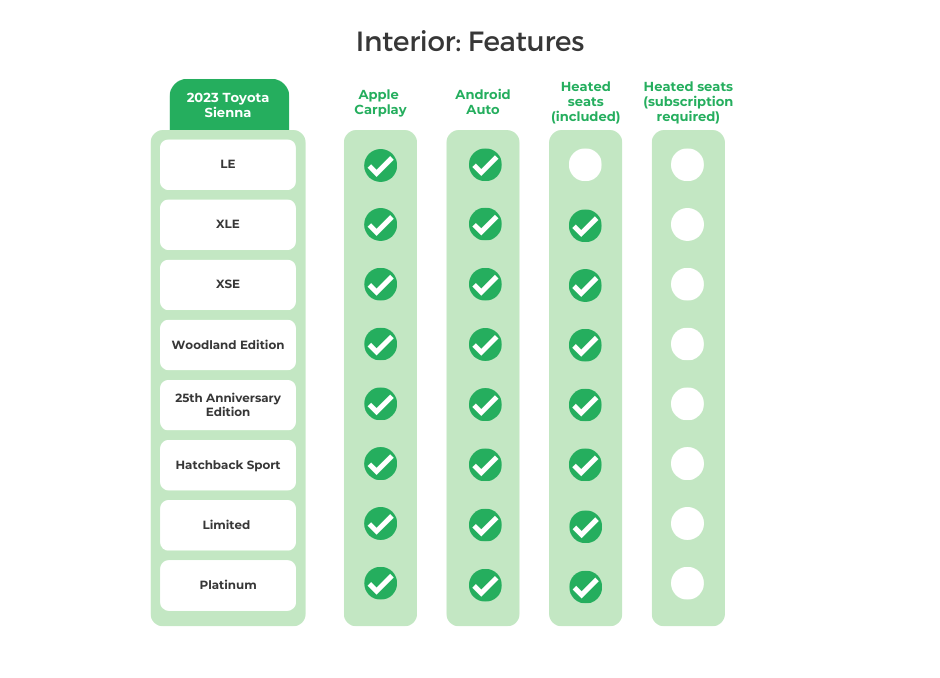
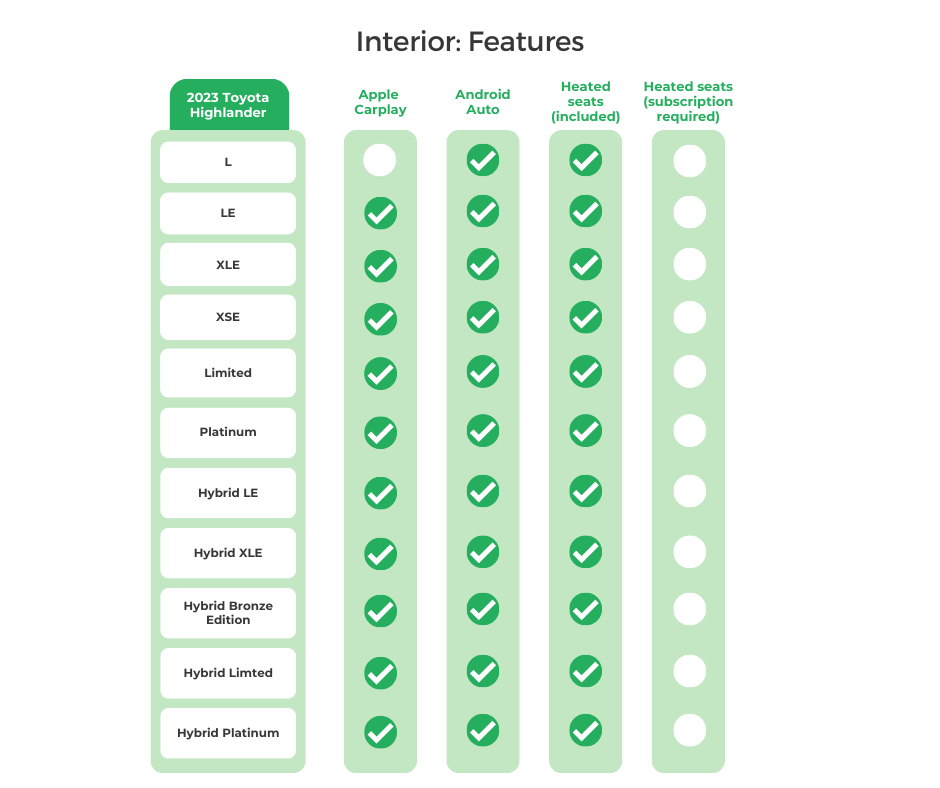
Interior Dimensions:
For anyone wondering what makes a minivan so much better than a crossover when it comes to hauling kids and gear around, the interior dimensions table below should shed some light on the subject. Both the 2023 Sienna and Highlander technically have room for up to 8, but the Highlander “comfortably” seats just 4 versus 6 in the Sienna.
The only spec the Highlander has an advantage in is front-row legroom, but in every other dimension, the Sienna pulls ahead. 11 more inches of 3rd-row legroom! 27 more cubic feet of volume behind the 2nd row! 5 more inches of shoulder room and NINE more inches of hip room in the middle row!
Sorry, I’ll calm down now. But it’s hard not to as the parent of three tiny humans that were put on this planet to push and shove each other in the car. Nine extra inches of hip room is basically manna from heaven for any parent. Just sayin’.
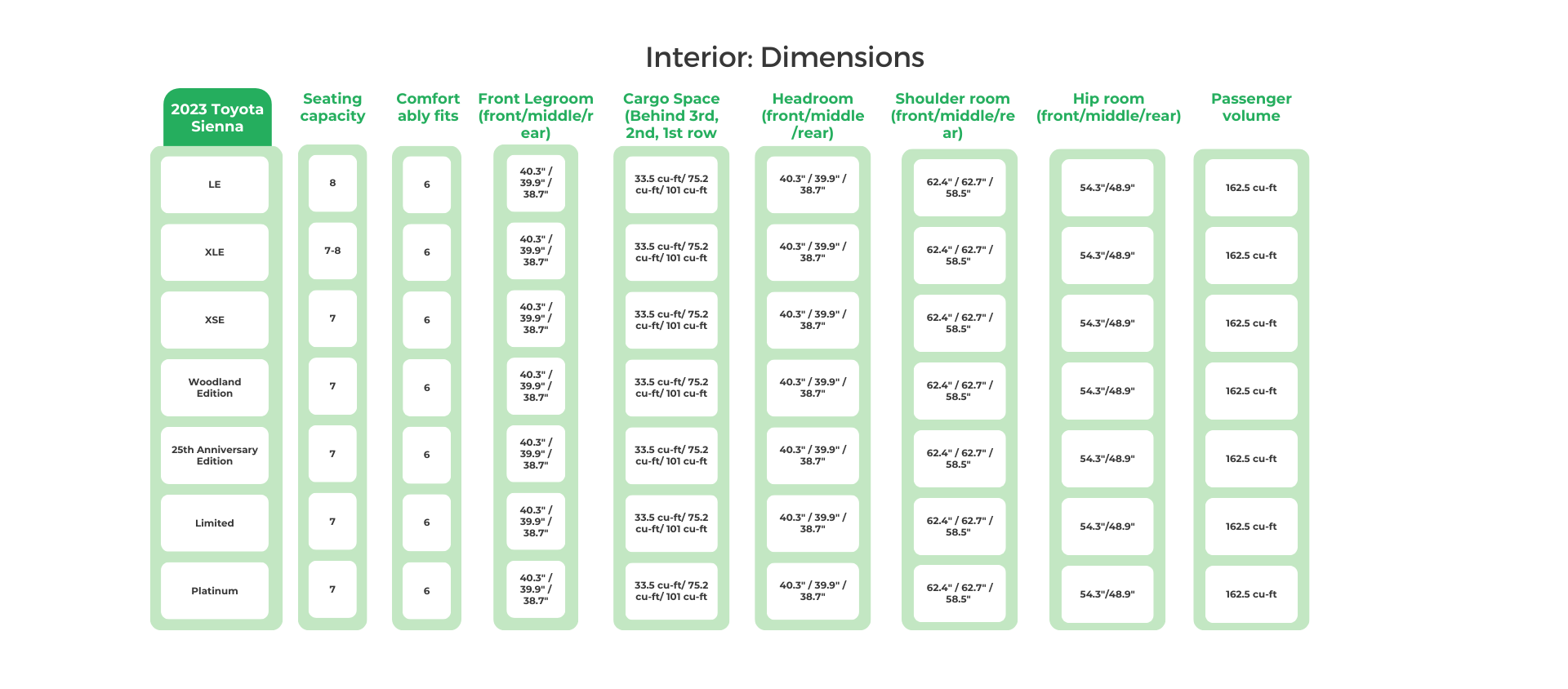
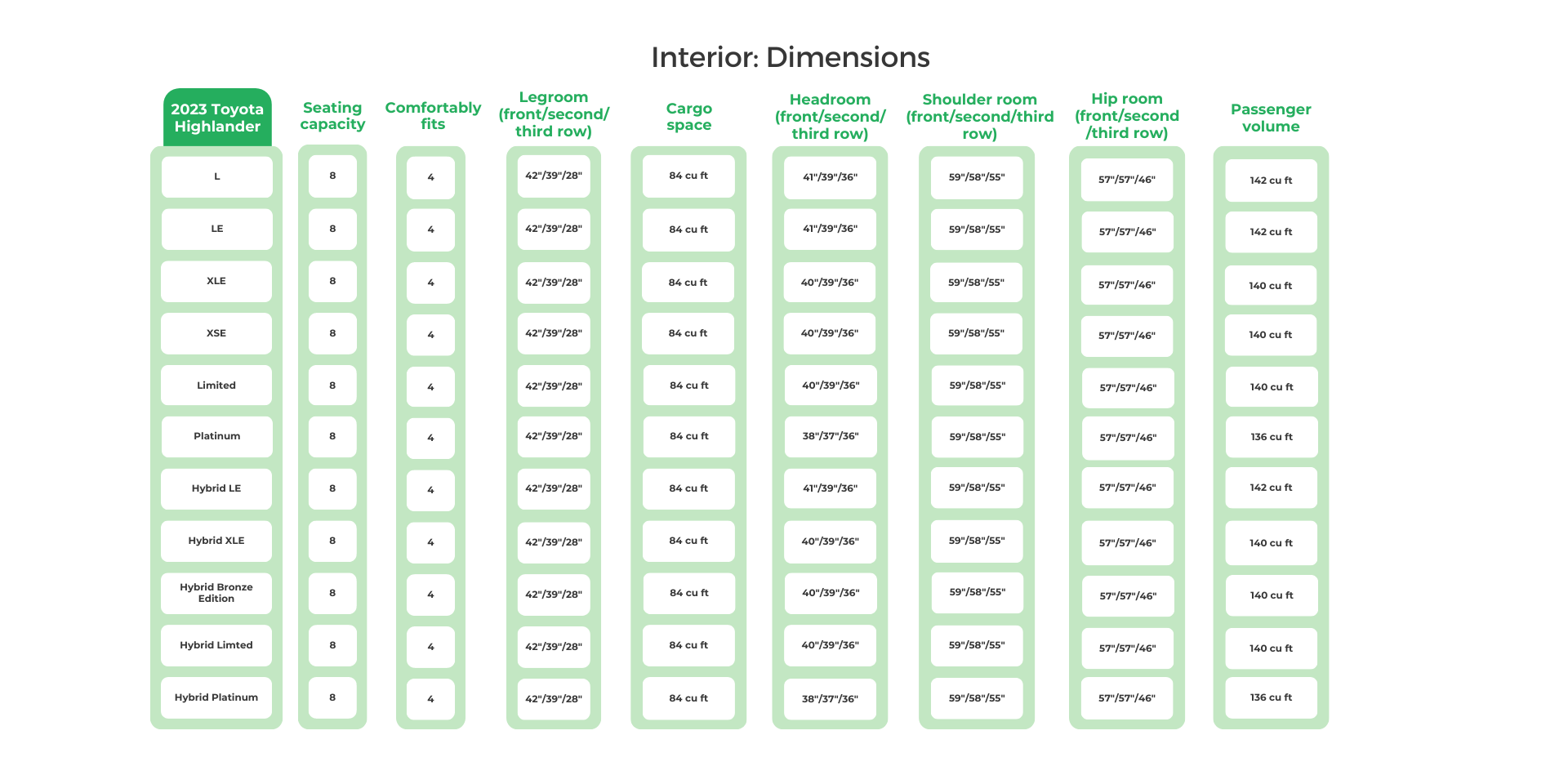
Exterior:
Exterior Features:
Feeling the need to style and perhaps even profile in your minivan? Toyota has you covered with the 2023 Sienna! This swagger wagon offers up to 20-inch rims, though in fairness so does the Highlander. You know what you won’t find on either option? Steelies and hubcaps.
Be aware that those bigger wheels carry a penalty in ride quality and are pricier to replace than the 17s or 18s fitted to base models. And though you can’t select a Supersonic Red paint job like the snazzy Toyota Camry, may I recommend the handsome Cypress green finish?
All that said, it’s kind of hard to beat the 2023 Highlander Bronze edition with its exclusive Cement paint finish and killer bronze-finished 18” rims.
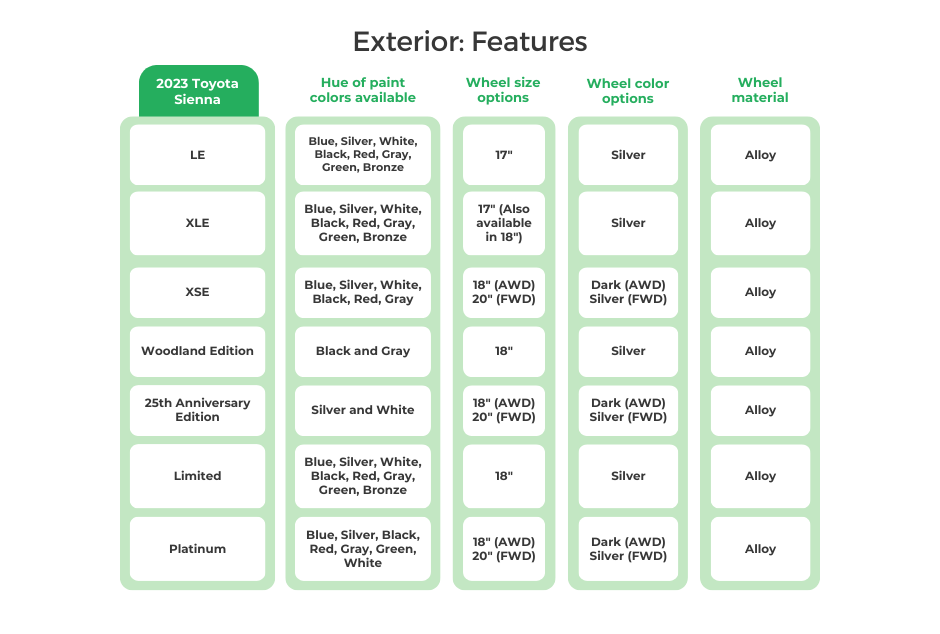
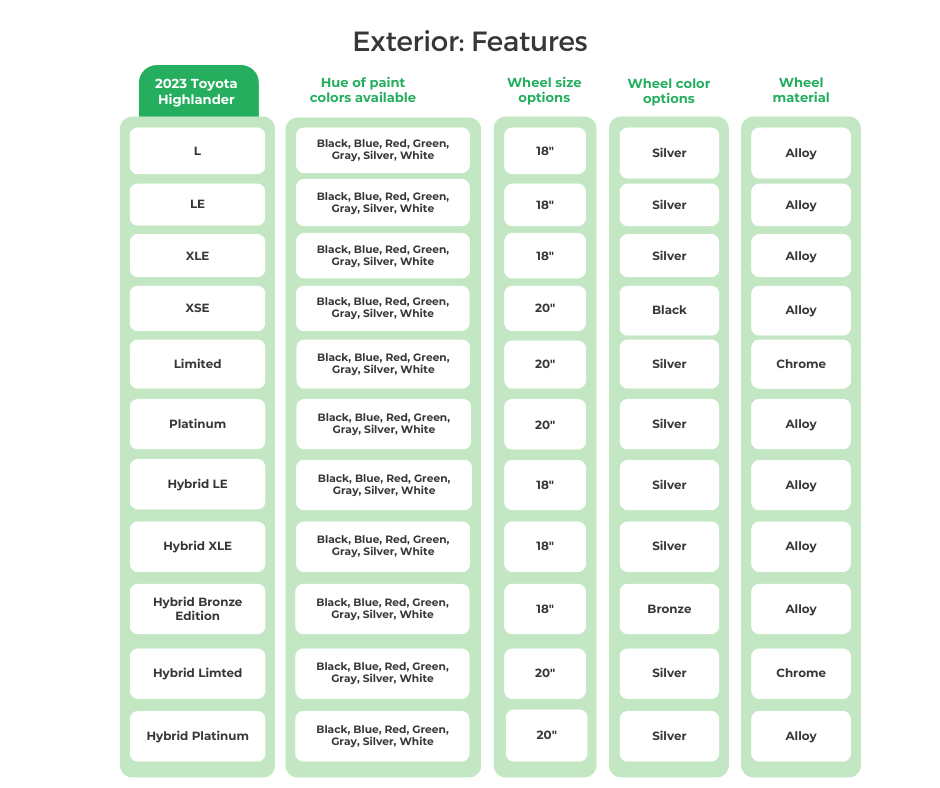
Exterior Dimensions:
Measuring nearly 9” longer with 8 more inches between the wheels, 2.5” wider, and almost 2” taller, it’s not surprising how much more interior space the 2023 Sienna has over the Highlander as discussed above. That size advantage comes with a weight penalty. Neither Toyota could be called svelte, but the Sienna is portlier overall.
The biggest differentiator in exterior dimensions is ground clearance. The 2023 Highlander offers 8 inches across the board, while most of the 2023 Sienna lineup comes in at 6.37 inches. Opt for the Woodland Edition to get closer to 7 inches, but don’t mistake either of these Toyotas for off-roaders – they’re not.


Warranty:
As you would expect, warranty coverage is identical on the 2023 Toyota Sienna and Highlander. If you’re cross-shopping the Sienna against a Honda Odyssey, it’s worth pointing out that both Honda and Toyota include 2 years of complimentary maintenance as part of their respective warranties.
However, if you’re comparing the Ford Explorer to the Highlander, be aware that Ford does not include free service. Other than that, it’s the industry average 3-year/36,000-mile basic coverage and 5-year/60,000-mile powertrain coverage. Hybrid battery coverage runs for 10 years or 150,000 miles on both Toyotas.
| 2023 Toyota Sienna Factory Warranty Coverage: | 2023 Toyota Highlander Factory Warranty Coverage: | |
| Basic warranty: | 36 months/36,000 miles | 36 Months/36,000 Miles |
| Powertrain warranty: | 60 months/60,000 miles | 60 Months/60,000 Miles |
| Corrosion perforation warranty: | 60 months/unlimited miles | 60 Months |
| Air conditioning warranty: | 12 months/12,000 miles | 12 Months/12,000 Miles |
| Battery warranty: | 120 months/150,000 miles | 120 months/150,000 miles (Hybrid Battery) |
| Emissions warranty: | Federal: 36 months/36,000 miles California: 36 months /50,000 miles | Federal: 36 month/36,000 miles (defect), 24 months/24,000 miles (performance) California: 36 months/50,000 miles (performance) |
| Roadside assistance coverage: | 24 months/unlimited miles | 24 months/25,000 miles |
| Total unique recalls: | 0 | 1 (related to driver’s airbag, NHTSA Campaign number: 23V480000) |
Driver Experience | A Summary of The Top 10 Toyota Sienna vs. Toyota Highlander Reddit Posts:
Nothing beats the What Car Should I Buy Reddit for an unvarnished perspective from Toyota Sienna and Highlander owners. So, we took a stroll through the commentary to look for any themes among folks considering these two vehicles.
Almost without fail, the consensus is that the Sienna is better than the Highlander if your vehicle needs are centered around a family with kids. Some highlights:
- “It’s hard to beat the space offered in the Sienna imho”
- “The regular Highlander isn’t that spacious”
- “Sienna unless you need towing or heavy off-road capability”
- “Sienna. Minivans do almost everything an SUV does but better”
Nobody seems to have a problem with the Highlander and if you need a bit more towing capacity or the extra ground clearance, some say it’s a better bet over the Sienna. But, by and large, the comments lean towards the Sienna.
As user, Can-Funny sums up so succinctly, “With two kids, you will NEVER regret having a minivan. Signed, a guy with two kids and a minivan…”
Who Should Buy These Cars: The Legacy of The Toyota Sienna & Toyota Highlander
| Frequent Use Categories: | Toyota Sienna | How Useful? (Out of 5 Stars) |
Toyota Highlander | How Useful? (Out of 5 Stars) |
| Family Vehicle | * * * * * | * * * * * |
| Lots of Driving (travel/long commute) | * * * | * * * |
| Hauling/Towing | * | * * |
| Office on Wheels | * | * |
| Sport/Fast Driving | * | * |
| Luxurious Driving | * | * |
| Outdoor/Off-Road | * | * |
Confirming the idea that crossovers have supplanted station wagons as the family vehicle of choice is the above table. It ranks the Toyota Sienna and Highlander as the most frequently used category based on owner survey responses.
As you can see, Family Vehicle is the top category for the Highlander and, as expected, the Toyota Sienna. This is followed closely by Lots of Driving AKA family road trips and daily commutes.
The Highlander has 1 more star in the Hauling/Towing category than the Sienna, but not by much. According to our data, 11% of Highlander owners – on average – use their Toyota for pulling a trailer versus 9% for Sienna owners.
It’s enough to hit the 2-star mark, but it also highlights the fact that neither of these vehicles are serious haulers. It’s also good to know when shopping for a used model as you are less likely to come across an option that has seen the added wear and tear that trailering results in.
Year-by-Year Comparison | Toyota Sienna vs. Toyota Highlander
Best & Worst Years | Toyota Sienna vs. Toyota Highlander | 2001-2024

The graphic above makes it easy to see which model years we recommend (green) and which to avoid (red) for both the Toyota Sienna and Toyota Highlander per our Best & Worst Model Years series.
If it’s the Sienna you’re after, stick to 2012 or later and you should be able to find a reasonably priced and reliable option. The Highlander offers highly reliable model years going back as far as 2002 and 2007, which is helpful for those on a tighter budget.
The 2007 Toyota Highlander is of particular interest here as it sits in the sweet spot of depreciation vs. residual value as discussed earlier.
The 2022-2024 model years are highlighted in yellow because we do not yet have enough data to make an informed decision on reliability and the blue circles indicate the start of a new generation. On that latter note, be wary of any vehicle’s first year of a new generation as it tends to be accompanied by reliability issues.
This is backed up by the Highlander earning a “Worst Year” rating in 2008, 2014, and 2020 – all of which marked the start of a new generation. The same is true for the Sienna in 2004 and 2011.
Important Features Timeline | Toyota Sienna vs. Toyota Highlander
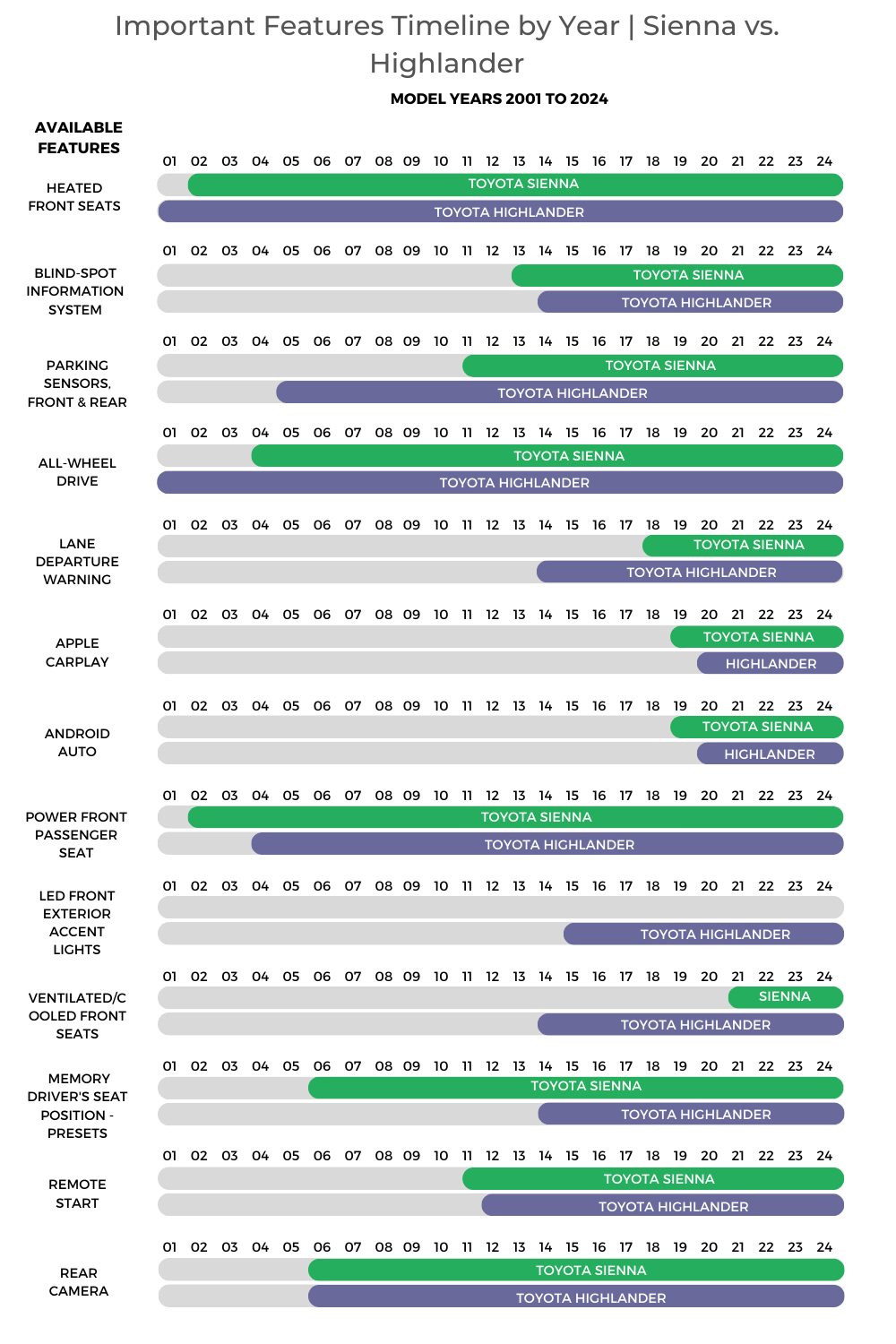
The above Features Timeline is intended to help buyers of used Siennas and Highlanders get a sense of when features important to them became available. For example, the Sienna has only been a hybrid minivan since 2021, but the Highlander offered a hybrid powertrain as far back as 2006.
Both Toyotas have been offering AWD for around 10 years and heated seats since the early 2000s. However, ventilated seats are a more recent addition with the Highlander making them optional as of 2014 and the Sienna bringing them on board in 2021.
Smartphone mirroring via Apple CarPlay and Android Auto seems to be standard across the auto industry today but has only been available on the Sienna since 2019 and the Highlander since 2020. While Toyota now equips its lineup with a long list of ADAS, blind-spot monitoring and lane departure warnings, they were available as far back as 2013.
You can go deeper on this topic with our best and worst model year articles for the Toyota Sienna and Toyota Highlander.
Maintenance Costs (Year-by-Year Average) | Toyota Sienna vs. Toyota Highlander

The chart above plots annual maintenance costs for the Toyota Sienna and Highlander according to owner-reported figures. Though there are some outliers, these Toyotas are close from an average perspective.
Between 2001 and 2021, the Sienna averaged $617 per year in upkeep costs, while the Highlander came in a bit higher at $646. Later model years tend to run lower as they also tend to have lower mileage, while the older these vehicles get, the higher the bills tend to run.
In particular, the 2005, 2006, and 2011 Toyota Sienna all go past $1,000 for this metric, which is part of the reason all three get a thumbs down on our best & worst Sienna model years ranking. The Highlander reached or exceeded $1,000 in 2012 and 2015.
However, that doesn’t preclude these two models from being on the right side of the best & worst Highlander model years as there are other factors at play in those rankings. One of which is that older cars aren’t automatically less reliable as some owners stay on top of maintenance, while others run their vehicles into the ground. So, as always, make sure to do your homework before buying.
Safety Rating Comparison | Toyota Sienna vs. Toyota Highlander

As with the new 2023 models, generally speaking, used Toyota Siennas and Highlanders earn solid safety ratings. Per the above chart, which plots the two Toyotas against one another using the average NHTSA score for a given year, we can see that these vehicles almost always stay above 4 out of 5.
Outliers include the 2002 and 2003 Highlander and both 2011 model years. It’s not clear why the earlier Highlanders fared worse, but in 2011, the NHTSA instituted stricter test protocols that drove an industry-wide decline in these ratings. As you can see Toyota recovered within the following few model years.
Another notable aspect of this comparison is how the Highlander drops from an average of 4.4 stars to 4.2 in 2020 and the Sienna drops from an average of 4.6 stars to 4.2 in 2021. In both instances, the year when the score declined coincided with the release of a new generation.
Looking into the data, we can see that with the Highlander, that drop in score was due to the front passenger-side crash test resulting in 4 stars versus 5 for the previous generation. With the Sienna, the reason behind the decline is the front driver-side test rating of 3 stars versus 5 for the prior series.
There is no clear evidence behind these safety ratings declines in the more recent model years, but you can look more closely at safety over the years for these Toyotas with our best and worst model years series that covers the Sienna and Highlander.
Fuel Efficiency Comparison | Toyota Sienna vs. Toyota Highlander
Given the latest Sienna comes only with a hybrid powertrain, fuel efficiency is an important topic in any comparison. To that end, we have two charts above. On the left, we compare the gas-powered efficiency of the Sienna and Highlander over the past 20 years. On the right, we do the same, but for hybrid models.
Between 2001 and 2016, both gas-powered Toyotas hovered around 20 mpg combined with the Highlander occasionally edging out the Sienna. Starting in 2017, the Highlander pulls ahead, but in either case, fuel economy figures increase over time. This is typical of the auto industry as modern technology helps drive powertrain efficiency.
Starting in 2021, the Sienna was only offered with a hybrid powertrain and as you can see, it is slightly more stingy with fuel than its modern Highlander stablemate. However, if you want to save money on the purchase price of a used car and keep fuel costs down, the Highlander has been offered as a hybrid for far longer – back in 2006.
For more insight into fuel economy for these two vehicles, be sure to check out our Best and Worst Model Years series for the Toyota Sienna and Toyota Highlander.
Methodology
- Compare two vehicles, Toyota Sienna vs. Toyota Highlander and provide a comprehensive analysis.
- Gather relevant information and data on both vehicles from reliable sources, such as manufacturer specifications, expert reviews, customer feedback, industry reports, and data sources like manufacturer websites, FIXD App, Kelley Blue Book, FuelEconomy.gov, and NHTSA.
- Collect data on various aspects, including performance, safety features, fuel efficiency, maintenance costs, reliability, owner satisfaction, and market value.
- Identify the key criteria that will be used to evaluate and compare the two vehicles.
- Ensure the criteria cover both objective factors (such as performance metrics, safety ratings, and fuel efficiency) and subjective factors (such as owner satisfaction, comfort, and features).
- Assess the performance of both vehicles based on factors such as acceleration, handling, braking, and overall driving experience.
- Compare engine options, horsepower, torque, transmission options, and any unique performance features.
- Examine the safety features and ratings of both vehicles.
- Evaluate crash test ratings, advanced driver assistance systems (ADAS), active and passive safety features, and any notable recalls or known issues related to safety.
- Consider both NHTSA safety ratings and IIHS awards for a comprehensive safety assessment.
- Analyze the fuel economy of both vehicles based on EPA mileage estimates.
- Compare their MPG ratings, average full-tank range, and any significant differences in fuel efficiency.
- Assess the average annual maintenance and repair costs for both vehicles.
- Consider data from surveyed owners and other reliable sources, such as FIXD App owner surveys, to determine the overall cost of ownership over time.
- Evaluate the reliability of both vehicles based on owner reports, FIXD App data, and any known issues or recalls.
- Consider factors such as engine reliability, common problems by model year, long-term durability, and owner reliability scores gathered from surveys.
- Consider owner satisfaction by gathering information from forums, online communities (Reddit: r/whatcarshouldIbuy), customer reviews, and owner reliability scores.
- Summarize key factors that owners appreciate and any common complaints or drawbacks mentioned by owners.
- Compare the features and technologies offered by both vehicles.
- Highlight any notable differences in terms of infotainment systems, connectivity options, driver assistance features, interior quality, and available upgrades.
- Assess the market value and depreciation of both vehicles.
- Compare average prices, resale value, and how the vehicles hold their value over time.
- Consider average private-seller valuations from Kelley Blue Book (KBB) for a comprehensive assessment.
- Summarize the findings of the comparison, highlighting the positives and negatives of each vehicle.
- Provide a fair and balanced recommendation based on the comparison, considering factors such as budget, personal preferences, specific needs of the buyer, and the comprehensive analysis conducted.
Sources:
-
- KBB Values: Average private-seller valuations as supplied by Kelley Blue Book (KBB), based on a Toyota Sienna and Toyota Highlander with typical mileage for that respective model year.
- Fuel Economy: Mileage-per-gallon estimates according to the EPA MPG on Fueleconomy.gov.
- Annual Maintenance/Repairs: Upkeep expenses as reported by surveyed Toyota Sienna and Toyota Highlander owners.
- Safety Ratings: Crash test data collected and reported by NHTSA. We average all ratings for each year to come up with a simplified, average safety score. This makes it easier to look at on a graph. We also collected IIHS Awards for this article.
- Vehicle Features: Most or all information gathered on vehicle features were from the manufacturer websites, in this case Toyota.com

Niel Stender grew up doing replacement work on his old Cherokee and sweet Mitsubishi Starion, which led to a degree in mechanical engineering and a job at Ford as a vehicle dynamics engineer. His writing infuses that automotive background with sales and marketing experience. Writing about cars for close to a decade now, he enjoys digging into some of the more technical mechanical systems under the hood and throughout a vehicle.

